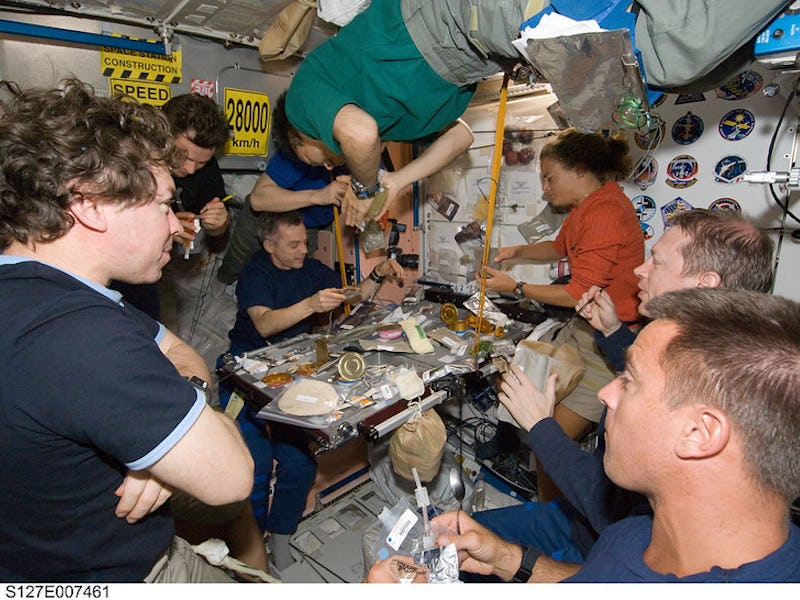15 Years Ago, the International Space Station Accidentally Tested An Unresolved Question
Why were so many people on the space lab at once?

Fifteen years ago, the International Space Station (ISS) hosted its largest crowd of spacefarers ever — a record that has yet to be broken.
A whopping 13 people, representing space agencies around the world, lived onboard humanity’s farthest outpost. Three missions, which consolidated into two, overlapped in the last half of July 2009.
A few factors triggered the large population in space. The orbiting laboratory was transitioning to six-person long-duration missions to boost scientific exploration and productivity in low-Earth orbit, whereas the earlier parts of the decade consisted of two- and three-person crews. The retirement of the Space Shuttles loomed just a few years into the future, too. So, NASA and its partners hustled to complete the desired additions to the space lab. Space Shuttle Endeavour launched for a short and intense two-week mission, carrying seven astronauts, to complete a major station project.
NASA astronaut Tim Kopra wears a spacewalk suit inside the Space Shuttle Endeavour's cargo bay. He’s performing the first of the STS-127 crew’s five planned spacewalks on the International Space Station.
The result was like “having your family descend on you for the holidays,” Spaceflight Now reported Mike Moses, director of shuttle integration at NASA, as having said about the 13-person crew.
Why was it so crowded?
The record held from July 15 to July 31, 2009, when the Endeavour mission STS-127 performed a tough 16-day mission requiring five spacewalks, the replacement of massive station batteries and the installation of the Exposed Facility on Japan’s Kibo Experiment ISS Module, or section. Kibo’s first portion arrived a year prior. The Exposed Facility would be a “‘front porch’ on which experiments will be mounted for long-duration exposure to the environment in low Earth orbit,” NASA officials wrote.
Already onboard the ISS was Russian cosmonaut Gennady Padalka as well as NASA astronaut Michael Barratt, who had arrived almost four months earlier via a Russian Soyuz capsule. Two weeks before they arrived, Japanese astronaut Koichi Wakata reached the ISS via the Space Shuttle Discovery, but remained behind when his shuttle crewmates returned to Earth. The duo became a trio.
While in the middle of the STS-127 mission’s second spacewalk, a crewmember snapped this photo of the space station and the top part of Endeavour.
Then two months later, the ISS transitioned to hosting six people on long-duration missions for the first time. Expeditions, as these missions are called, typically last six months. This major change went into effect in late May 2009, when cosmonaut Roman Romanenko, European astronaut Frank De Winne and Canadian astronaut Robert Thirsk arrived at the ISS. This turned Expedition 19 into Expedition 20.
This was a major turning point. NASA and Russian space agency Roscosmos shrunk their initial three-person Expeditions to duos, following the Space Shuttle Columbia disaster of 2003. They held this policy for three years before returning to trio crews. The shuttle program’s ballooning costs, coupled with the public relations all contributed to NASA’s move to ready the Space Shuttles into retirement. But the vehicle was unique — its massive cargo hull provided the only way a craft on the scale of the ISS could be constructed. To this day, as NASA and its partners contemplate how to deorbit the ISS next decade, the Space Shuttle’s absence is strongly felt.
A station construction crew followed shortly after the start of Expedition 20. The space shuttle Endeavour launched its critical cargo along with seven people: NASA astronauts Mark Polansky, Doug Hurley, David Wolf, Christopher Cassidy, Tom Marshburn, Tim Kopra and Canadian astronaut Julie Payette.
Pictured from the left, front row, are NASA astronauts Michael Barratt, Mark Polansky, Russian cosmonaut Gennady Padalka and NASA astronaut Dave Wolf. Pictured from the left, middle row, are Japan Aerospace Exploration Agency (JAXA) astronaut Koichi Wakata, Canadian Space Agency astronauts Julie Payette, Robert Thirsk and NASA astronaut Tom Marshburn. Pictured from the left, back row, are Russian cosmonaut Roman Romanenko, NASA astronauts Christopher Cassidy, Doug Hurley, Tim Kopra and European Space Agency astronaut Frank De Winne.
The shuttle crew anticipated strains, Spaceflight Now reported. The astronauts knew STS-127 was one of the program’s most intense ever, or as Payette put it, packed with “heavy duty construction.” She added there would be “growing pains” while each mission did their thing. Knowing how to manage this “population explosion,” Wolf said, was critical.
They also described the cultural sensitivity that would be needed. When Expedition 20 reached the ISS, it was the first time that all five space agencies partnering on the ISS had a representative living onboard.
The 13 station dwellers brought the jam-packed stay to an end when Endeavour returned to Earth on July 31, 2009.